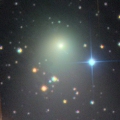
|
It became much brighter than expected. Now it is so bright as 9.0 mag (Sept. 11, Chris Wyatt). It keeps bright as 8-9 mag until autumn. In the Southern Hemisphere, it will keep observable in good condition for a long time until 2014 summer when the comet fades out. It will never be observable again in the Northern Hemisphere.
Date(TT) R.A. (2000) Decl. Delta r Elong. m1 Best Time(A, h)
Sept.21 9 20.10 -24 44.2 2.078 1.539 44 8.9 4:27 (282, 27)
Sept.28 9 40.26 -29 32.3 2.087 1.574 46 9.1 4:16 (288, 28)
|
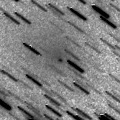
|
Brightening very rapidly. It has already brightened up to 11.0 mag (Sept. 13, Juan Jose Gonzalez). It will pass the perihelion on Nov. 21, and will brighten up to 7 mag. In the Northern Hemisphere, it keeps observable in excellent condition while the comet is brightening rapidly in the morning sky. In the Southern Hemisphere, it is observable only until early October.
Date(TT) R.A. (2000) Decl. Delta r Elong. m1 Best Time(A, h)
Sept.21 5 29.20 40 33.2 0.763 1.302 93 12.1 4:27 (192, 13)
Sept.28 6 22.25 42 50.1 0.647 1.197 90 10.8 4:16 (198, 9)
|
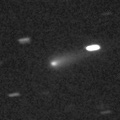
|
Now it is 11.1 mag (Sept. 16, Tsutomu Seki). It is expected to be a great comet in 2013 autumn when the comet approaches to the sun down to only 0.01 A.U. It keeps visible with naked eyes from November to January, and can be extremely bright as Venus or more at the highlight. But recently, it is fainter than originally expected by 2 mag. It may be 3 mag at best actually when it is observable in the morning sky. The condition is excellent in the Northern Hemisphere. It keeps observable almost all through the period of brightening, at the highlight, and of fading. The condition is not good in the Southern Hemisphere. It is not observable at all the latter part of the highlight, and it keeps low all through the period.
Date(TT) R.A. (2000) Decl. Delta r Elong. m1 Best Time(A, h)
Sept.21 9 14.88 19 26.7 2.439 1.835 42 11.9 4:27 (244, 3)
Sept.28 9 28.36 18 13.1 2.238 1.707 46 11.5 4:16 (244, 4)
|
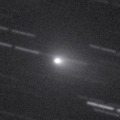
|
New bright comet. Now it is 12.2 mag (Sept. 11, Chris Wyatt). It will pass only 0.4 A.U. from the earth, and 0.8 A.U. from the sun in November and December, and will brighten up to 6 mag. In the Northern Hemisphere, it keeps observable in excellent condition for a long time until 2014 autumn when the comet will fade out. In the Southern Hemisphere, it will not be observable from mid November to early February. But it keeps observable in good condition until mid November when the comet will brighten up to 7 mag.
Date(TT) R.A. (2000) Decl. Delta r Elong. m1 Best Time(A, h)
Sept.21 6 18.91 -5 5.8 1.606 1.796 83 12.1 4:27 (228, 50)
Sept.28 6 30.78 -4 0.2 1.436 1.702 86 11.6 4:16 (225, 50)
|
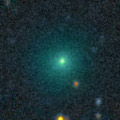
|
New bright comet discovered in the extremely low sky at dawn. Now it is 11.8 mag (Aug. 30, Ken-ichi Kadota). It keeps 11-13 mag until autumn, but it keeps locating extremely low in the morning sky. It is not observable until November in the Southern Hemisphere. Juan Jose Gonzalez reported it is so bright as 8.8 mag on Aug. 18.
Date(TT) R.A. (2000) Decl. Delta r Elong. m1 Best Time(A, h)
Sept.21 10 29.82 12 20.9 2.154 1.298 23 11.8 4:27 (260, -8)
Sept.28 10 46.61 8 18.4 2.180 1.339 24 12.0 4:16 (264, -5)
|
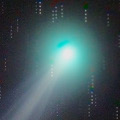
|
It approached to the sun down to 0.73 A.U. on Mar. 24, and brightened up to 4.7 mag (Mar. 11, Michael Mattiazzo). Now it is fading. But it is still bright as 12.1 mag (Sept. 14, Todd Augustyniak). In the Northern Hemisphere, it keeps observable in good condition while fading gradually. In the Southern Hemisphere, it will never be observable again.
Date(TT) R.A. (2000) Decl. Delta r Elong. m1 Best Time(A, h)
Sept.21 18 44.55 61 19.9 2.681 2.952 95 11.8 19:19 (176, -7)
Sept.28 18 40.73 59 24.7 2.788 3.037 94 12.0 19:25 (171, -6)
|
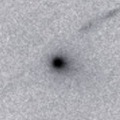
|
Brightening very rapidly. It has already brightened up to 14.2 mag (Sept. 5, Alan Hale). It is expected to reach up to 10 mag from autumn to winter. In the Northern Hemipshere, it keeps observable in excellent condition until the comet fades out. In the Southern Hemisphere, it keeps observable in good condition within 2013, but it will not be observable in 2014.
Date(TT) R.A. (2000) Decl. Delta r Elong. m1 Best Time(A, h)
Sept.21 22 11.56 -9 44.9 0.889 1.842 153 13.0 22:09 (180, 65)
Sept.28 22 5.33 -8 6.2 0.890 1.807 145 12.6 21:35 (180, 63)
|

|
The condition is worst and the comet will be hardly observable in this apparition. In the Northern Hemisphere, it will be observable in autumn when the comet will be fainter than 16 mag.
Date(TT) R.A. (2000) Decl. Delta r Elong. m1 Best Time(A, h)
Sept.21 10 57.70 13 41.6 2.336 1.422 18 13.2 4:27 (263,-14)
Sept.28 11 17.36 12 3.0 2.375 1.479 20 13.7 4:16 (265,-14)
|

|
Now it is 11.7 mag (Sept. 6, Sandor Szabo). It keeps bright at 13-14 mag for a long time until 2014. It keeps observable for a long time in the Northern Hemisphere. It locates somewhat low in the Southern Hemisphere.
Date(TT) R.A. (2000) Decl. Delta r Elong. m1 Best Time(A, h)
Sept.21 19 23.35 20 23.6 5.532 5.964 110 13.3 19:21 (180, 35)
Sept.28 19 20.46 18 56.9 5.627 5.972 105 13.4 19:25 (170, 36)
|

|
Big asteroid discovered in 1906. It suddenly showed the cometary activity on Dec. 11, 2010, probably due to an impact of a small object. It has already turned to be stellar.
Date(TT) R.A. (2000) Decl. Delta r Elong. m1 Best Time(A, h)
Sept.21 0 45.49 -17 11.1 2.098 3.057 159 13.4 0:47 (180, 72)
Sept.28 0 39.54 -17 37.0 2.108 3.068 159 13.4 0:14 (180, 73)
|

|
It brightened up to 11-12 mag in 2012. Now it is bright as 13.7 mag (July 24, Taras Prystavski). It is already unobservable in the Northern Hemisphere. It will be unobservable in late September also in the Southern Hemisphere. However, it will be observable again at 14 mag after December.
Date(TT) R.A. (2000) Decl. Delta r Elong. m1 Best Time(A, h)
Sept.21 13 15.20 -11 2.8 7.347 6.441 23 13.8 19:19 ( 80, 5)
Sept.28 13 16.72 -11 18.0 7.421 6.471 17 13.9 19:25 ( 75, -1)
|
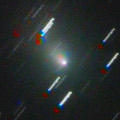
|
It brightened up to 9-10 mag in 2013 spring. Now it is fading. It has already faded down to 14.6 mag (Aug. 28, Hidetaka Sato). In the Southern Hemisphere, it keeps observable for a long time until the comet fades out, although it keeps locating low. It will never be observable again in the Northern Hemisphere.
Date(TT) R.A. (2000) Decl. Delta r Elong. m1 Best Time(A, h)
Sept.21 10 49.78 -49 21.2 2.827 2.346 51 13.9 4:27 (316, 22)
Sept.28 11 12.19 -51 33.7 2.905 2.412 51 14.1 4:16 (318, 23)
|
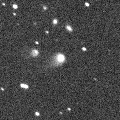
|
Now it is 14.0 mag and visible visually (Sept. 6, Sandor Szabo). It is expected to brighten up to 5-6 mag in 2014 autumn. In the Northern Hemisphere, it keeps observable in good condition for a long time, although it will be unobservable temporarily in late November. In the Southern Hemisphere, it will be unobservable in late September, then it keeps unobservable until 2014 February.
Date(TT) R.A. (2000) Decl. Delta r Elong. m1 Best Time(A, h)
Sept.21 15 35.97 14 47.4 5.016 4.546 56 14.1 19:19 (123, 17)
Sept.28 15 36.88 14 6.9 5.025 4.475 51 14.0 19:25 (117, 12)
|

|
Now it is bright as 13.0 mag (Aug. 28, Taras Prystavski). It is already unobservable in the Northern Hemisphere. It keeps observable until early October in the Southern Hemisphere.
Date(TT) R.A. (2000) Decl. Delta r Elong. m1 Best Time(A, h)
Sept.21 14 9.95 -22 0.4 6.924 6.195 40 14.1 19:19 ( 78, 22)
Sept.28 14 14.90 -22 19.8 6.987 6.193 34 14.2 19:25 ( 74, 17)
|
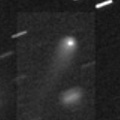
|
Now it is 14.5 mag (June 11, Sandor Szabo). It keeps 13 mag and observable in good condition in the Northern Hemisphere for a long time from 2013 to 2014. In the Southern Hemisphere, it is not observable until 2014 autumn.
Date(TT) R.A. (2000) Decl. Delta r Elong. m1 Best Time(A, h)
Sept.21 10 24.07 57 5.9 3.965 3.554 59 14.3 4:27 (218,-29)
Sept.28 10 33.18 58 30.0 3.864 3.539 63 14.3 4:16 (216,-28)
|
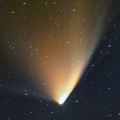
|
It passed the perihelion on Mar. 10, and brightened up to 0-1 mag. Now it is fading. It has already faded down to 13.2 mag (Sept. 6, Sandor Szabo). It is observable in good condition in the Northern Hemisphere. It is not observable in the Southern Hemisphere.
Date(TT) R.A. (2000) Decl. Delta r Elong. m1 Best Time(A, h)
Sept.21 15 24.13 35 1.5 3.814 3.422 59 14.5 19:19 (135, 1)
Sept.28 15 30.83 33 29.4 3.943 3.509 57 14.8 19:25 (130, -2)
|
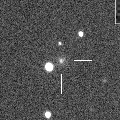
|
It is expected to brighten up to 11 mag and become observable in excellent condition in 2014 spring. In the Northern Hemisphere, it keeps extremely low in August and September. But it will be getting higher gradually in the morning sky after October. In the Southern Hemisphere, it is not observable until 2014 February.
Date(TT) R.A. (2000) Decl. Delta r Elong. m1 Best Time(A, h)
Sept.21 11 54.94 29 13.4 3.380 2.542 28 14.7 19:19 (105,-33)
Sept.28 12 10.29 28 15.8 3.292 2.478 30 14.5 4:16 (256,-33)
|

|
It will approach to the sun down to 0.14 A.U. on Oct. 7. Now it is not observable. In the Northern Hemisphere, it keeps observable at 16 mag in good condition from late October to mid December. In the Southern Hemisphere, it locates very low from November to December.
Date(TT) R.A. (2000) Decl. Delta r Elong. m1 Best Time(A, h)
Sept.21 10 10.78 8 28.0 1.247 0.568 26 15.5 4:27 (261, -2)
Sept.28 11 7.52 1 38.2 1.188 0.388 17 14.6 4:16 (272, -6)
|
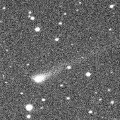
|
Now it is 14.3 mag (July 8, Chris Wyatt). It keeps bright as 13-14 mag for a long time from 2013 to 2014. In the Northern Hemisphere, it will be low in late September. In the Southern Hemisphere, it keeps observable until late October.
Date(TT) R.A. (2000) Decl. Delta r Elong. m1 Best Time(A, h)
Sept.21 15 8.13 -18 17.5 3.714 3.190 51 14.9 19:19 ( 89, 32)
Sept.28 15 17.19 -19 2.7 3.777 3.181 47 14.9 19:25 ( 85, 28)
|

|
It brightened up to 12 mag in 2012. It is bright as 13.3 mag still now (July 1, Hidetaka Sato). It keeps 13-14 mag until autumn. It locates somewhat low in the Northern Hemisphere.
Date(TT) R.A. (2000) Decl. Delta r Elong. m1 Best Time(A, h)
Sept.21 19 19.81 -35 55.3 2.676 3.135 107 15.2 19:19 ( 8, 89)
Sept.28 19 23.98 -35 37.5 2.781 3.149 102 15.3 19:25 ( 82, 84)
|
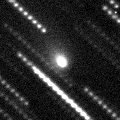
|
It brightened up to 14.5 mag in July (July 16, M. Brusa, L. Sempio). Now it is fading. In the Southern Hemisphere, it keeps observable for a long time until the comet fades out. It will be unobservable in October in the Northern Hemisphere.
Date(TT) R.A. (2000) Decl. Delta r Elong. m1 Best Time(A, h)
Sept.21 18 2.07 -35 58.1 2.050 2.320 92 15.2 19:19 ( 80, 74)
Sept.28 17 56.63 -37 49.8 2.199 2.330 84 15.4 19:25 ( 74, 66)
|
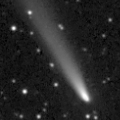
|
It approached to the sun down to 0.8 a.u. on Aug. 6, and brightened very rapidly. Now it is so bright as 13.2 mag (Aug. 27, Taras Prystavski). In the Southern Hemisphere, it keeps observable at 13 mag in good condition in the evening sky until September. It is extremely low in the Northern Hemisphere.
Date(TT) R.A. (2000) Decl. Delta r Elong. m1 Best Time(A, h)
Sept.21 16 43.08 -43 8.9 0.629 1.068 77 15.2 19:19 ( 63, 59)
Sept.28 17 50.34 -43 58.7 0.659 1.137 83 16.0 19:25 ( 60, 65)
|

|
Brightened rapidly. Now it is so bright as 12.3 mag and visible visually (Aug. 28, Marco Goiato). It keeps observable in excellent condition until autumn.
Date(TT) R.A. (2000) Decl. Delta r Elong. m1 Best Time(A, h)
Sept.21 21 10.52 4 23.2 1.304 2.165 139 15.2 21:09 (180, 51)
Sept.28 21 11.94 4 32.3 1.360 2.175 133 15.3 20:43 (180, 50)
|
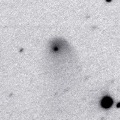
|
Now it is 15.5 mag (Aug. 25, Ken-ichi Kadota). It keeps 15 mag and observable in good condition in 2013. It locates somewhat low in the Northern Hemisphere.
Date(TT) R.A. (2000) Decl. Delta r Elong. m1 Best Time(A, h)
Sept.21 4 7.79 -25 12.1 6.616 7.083 113 15.2 4:09 (180, 80)
Sept.28 4 5.22 -25 26.1 6.579 7.114 118 15.2 3:39 (180, 80)
|
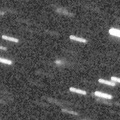
|
First return of a new periodic comet discovered in 1998. It brightened up to 10 mag at the discovery. Now it is 15.0 mag (Sept. 5, Michael Jager). In the Northern Hemisphere, it keeps observable in excellent condition from autumn to spring. A bit fainter than originally expected, but it will brighten up to 12 mag. It locates somewhat low in the Southern Hemisphere.
Date(TT) R.A. (2000) Decl. Delta r Elong. m1 Best Time(A, h)
Sept.21 5 56.54 40 46.7 2.497 2.671 88 15.7 4:27 (197, 11)
Sept.28 6 7.09 41 1.4 2.381 2.636 93 15.4 4:16 (196, 12)
|
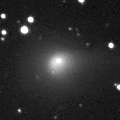
|
Fading slowly. Now it is 14.5 mag (Sept. 16, Mitsunori Tsumura). It keeps observable in good condition until the comet will be fainter than 18 mag in December.
Date(TT) R.A. (2000) Decl. Delta r Elong. m1 Best Time(A, h)
Sept.21 1 6.87 2 11.4 1.971 2.940 161 15.7 1:08 (180, 53)
Sept.28 1 1.65 0 52.5 2.021 3.011 168 15.8 0:36 (180, 54)
|
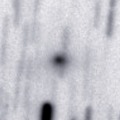
|
It brightened up to 2 mag by unusual major outburst in 2007. It will return in 2014. It will be 14 mag at best by normal prediction. But actually, it is brighter than predicted. It has already brightened up to 15.6 mag (Sept. 14, J. F. Hernandez).
Date(TT) R.A. (2000) Decl. Delta r Elong. m1 Best Time(A, h)
Sept.21 17 27.32 -36 17.6 2.368 2.496 85 15.8 19:19 ( 79, 67)
Sept.28 17 37.12 -35 25.7 2.426 2.469 80 15.7 19:25 ( 79, 62)
|
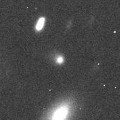
|
Now it is 16.8 mag (Sept. 10, A. Maury, J. G Bosch, J. F Soulier). It is expected to brighten up to 7.5 mag and to be observable in excellent condition from summer to autumn in 2014 in the Southern Hemisphere. The condition is bad in the Northern Hemisphere. It will pass extremely close to Mars in 2014 October.
Date(TT) R.A. (2000) Decl. Delta r Elong. m1 Best Time(A, h)
Sept.21 5 36.56 -24 24.2 4.773 4.946 93 16.0 4:27 (240, 71)
Sept.28 5 34.76 -25 50.2 4.625 4.881 98 15.9 4:16 (234, 76)
|
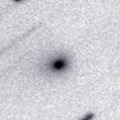
|
Brightening extremely rapidly. Now it is bright as 15.4 mag (Aug. 31, Ken-ichi Kadota). It has already passed the perihelion, but it may keep 16 mag some more time.
Date(TT) R.A. (2000) Decl. Delta r Elong. m1 Best Time(A, h)
Sept.21 17 30.34 -24 3.5 1.502 1.736 85 16.2 19:19 (107, 64)
Sept.28 17 49.12 -24 55.4 1.574 1.755 82 16.4 19:25 (102, 61)
|
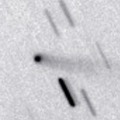
|
Now it is 16.9 mag (Sept. 4, D. buczynski). It will be observable at 16 mag in good condition in summer and autumn.
Date(TT) R.A. (2000) Decl. Delta r Elong. m1 Best Time(A, h)
Sept.21 0 24.91 17 26.7 1.315 2.285 160 16.4 0:27 (180, 37)
Sept.28 0 21.42 15 43.1 1.319 2.304 166 16.4 23:51 (180, 39)
|
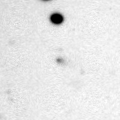
|
Now it is 16.4 mag (Aug. 19, A. Klotz, F. Kugel, J. Nicolas, J. Caron)). It tends to be brightest 4 months after the perihelion passage. It will reach up to 15.5 mag from autumn to winter, and will be observable in excellent condition.
Date(TT) R.A. (2000) Decl. Delta r Elong. m1 Best Time(A, h)
Sept.21 5 55.88 16 28.0 1.647 1.914 88 16.7 4:27 (206, 34)
Sept.28 6 6.83 16 27.3 1.597 1.932 93 16.5 4:16 (205, 35)
|
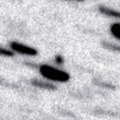
|
It reaches up to 12 mag in 2014 spring. But the condition in this apparition is bad. It locates low around the brightest days. Now it is 15.7 mag (Aug. 26, J. Aledo). It keeps observable in good condition until winter when the comet will brighten up to 15-16 mag.
Date(TT) R.A. (2000) Decl. Delta r Elong. m1 Best Time(A, h)
Sept.21 19 9.50 -11 55.9 2.303 2.796 108 16.7 19:19 (173, 67)
Sept.28 19 11.69 -12 20.2 2.353 2.753 102 16.6 19:25 (154, 65)
|
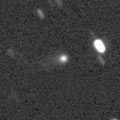
|
It was observed at 15-16 mag in 2012. Now it is fading slowly. But it keeps 15.6 mag still now (Sept. 16, Catalina Sky Survey). It will be fainter than 18 mag at the end of 2013. It locates low in the Southern Hemisphere.
Date(TT) R.A. (2000) Decl. Delta r Elong. m1 Best Time(A, h)
Sept.21 1 25.66 32 36.7 3.727 4.543 140 16.6 1:27 (180, 22)
Sept.28 1 16.42 31 10.0 3.703 4.580 147 16.7 0:51 (180, 24)
|
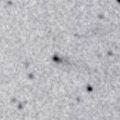
|
Now it is 18.0 mag (Sept. 1, J. Aledo). It keeps 17 mag for a long time from 2013 summer to early 2015.
Date(TT) R.A. (2000) Decl. Delta r Elong. m1 Best Time(A, h)
Sept.21 2 13.80 18 4.9 2.354 3.193 140 16.9 2:15 (180, 37)
Sept.28 2 11.54 17 52.0 2.289 3.182 147 16.8 1:45 (180, 37)
|
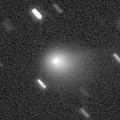
|
It brightened up to 9.0 mag in 2012 autumn (Nov. 4, Juan Jose Gonzalez). However, it faded out unexpectedly around the perihelion passage. Now it is fainter than originally predicted by 4-5 mag. It has already faded down to 17.6 mag (Aug. 31, A. Maury, J. F Soulier, T. Noel, J. G. Bosch). In the Southern Hemisphere, it keeps observable in good condition while fading slowly after this. In the Northern Hemisphere, it will not be observable after this.
Date(TT) R.A. (2000) Decl. Delta r Elong. m1 Best Time(A, h)
Sept.21 3 58.95 -52 22.3 3.086 3.521 107 17.0 4:00 ( 0, 73)
Sept.28 3 53.28 -53 2.8 3.129 3.584 109 17.1 3:27 ( 0, 72)
|

|
It brightened up to 12-13 mag from autumn to winter in 2012. Now it is fading. It has already faded down to 16.3 mag (Sept. 14, P. C. Sherrod, L. P. Sherrod). It keeps observable for a long time until the end of 2013 when the comet becomes fainter than 18 mag.
Date(TT) R.A. (2000) Decl. Delta r Elong. m1 Best Time(A, h)
Sept.21 6 6.51 8 54.1 4.104 4.164 86 17.1 4:27 (213, 40)
Sept.28 6 9.40 7 59.0 4.043 4.205 92 17.1 4:16 (210, 42)
|
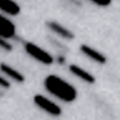
|
Now it is 16.4 mag (Sept. 16, Mt. Lemmon Survey). It was observed at 18 mag in 2012. It will be observable at 17 mag in excellent condition in 2013.
Date(TT) R.A. (2000) Decl. Delta r Elong. m1 Best Time(A, h)
Sept.21 23 33.45 1 1.4 3.404 4.405 174 17.1 23:30 (180, 54)
Sept.28 23 24.98 -1 5.4 3.434 4.414 166 17.1 22:54 (180, 56)
|

|
Now it is 17.8 mag (Sept. 1, Catalina Sky Survey). It will be observable at 17 mag in excellent condition from autumn to winter.
Date(TT) R.A. (2000) Decl. Delta r Elong. m1 Best Time(A, h)
Sept.21 3 10.37 21 41.8 1.933 2.659 126 17.4 3:11 (180, 33)
Sept.28 3 11.41 21 38.9 1.858 2.648 133 17.3 2:45 (180, 33)
|
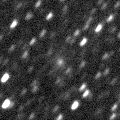
|
Now it is 17.2 mag (Aug. 1, M. Casali, A. Coffano. W. Marinello, M. Micheli, G. Pizzetti). It will be fading after this, and will be fainter than 18 mag in late October.
Date(TT) R.A. (2000) Decl. Delta r Elong. m1 Best Time(A, h)
Sept.21 18 36.66 -7 22.3 2.787 3.138 101 17.4 19:19 (157, 61)
Sept.28 18 42.09 -7 39.4 2.895 3.157 95 17.5 19:25 (145, 58)
|
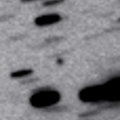
|
Now it is 17.8 mag (Sept. 15, J. L. Salto). It keeps observable at 18 mag for a long time from 2013 to 2016. It keeps locating high in the Northern Hemisphere. It keeps locating very low in the Southern Hemipshere.
Date(TT) R.A. (2000) Decl. Delta r Elong. m1 Best Time(A, h)
Sept.21 18 39.44 25 31.7 6.591 6.840 100 17.4 19:19 (169, 29)
Sept.28 18 37.35 25 10.9 6.660 6.825 95 17.5 19:25 (160, 27)
|
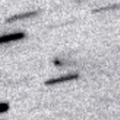
|
Now it is 18.2 mag (Sept. 13, Mt. Lemmon Survey). It will brighten up to 16.5 mag and will be observable in good condition from autumn to winter.
Date(TT) R.A. (2000) Decl. Delta r Elong. m1 Best Time(A, h)
Sept.21 3 13.84 17 10.3 1.492 2.247 127 17.6 3:15 (180, 38)
Sept.28 3 16.80 16 25.3 1.419 2.232 133 17.4 2:50 (180, 38)
|
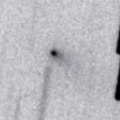
|
Now it is 17.1 mag (Sept. 16, Catalina Sky Survey). It will brighten up to 17 mag and will be observable in good condition from summer to autumn.
Date(TT) R.A. (2000) Decl. Delta r Elong. m1 Best Time(A, h)
Sept.21 0 4.62 25 42.4 1.026 1.975 153 17.5 0:07 (180, 29)
Sept.28 23 54.68 27 17.8 1.031 1.981 154 17.5 23:24 (180, 28)
|
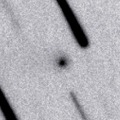
|
Now it is 17.6 mag (Aug. 9, K. Hills). It keeps 17 mag for a long time from 2012 to 2013, and will be observable in good condition in the Southern Hemisphere. It is not observable at all in the Northern Hemisphere.
Date(TT) R.A. (2000) Decl. Delta r Elong. m1 Best Time(A, h)
Sept.21 21 40.93 -75 13.6 4.831 5.153 103 17.5 21:38 ( 0, 50)
Sept.28 21 19.98 -73 48.4 4.909 5.172 99 17.6 20:50 ( 0, 51)
|

|
Now it is 17.7 mag (July 20, A. Novichonok, T. Prystavski). It will brighten up to 14 mag around the perihelion passage in 2019. In 2013, it will be observable in good condition at 17.5 mag from summer to winter. It locates low in the Southern Hemisphere.
Date(TT) R.A. (2000) Decl. Delta r Elong. m1 Best Time(A, h)
Sept.21 3 9.30 26 48.0 13.359 13.962 125 17.6 3:10 (180, 28)
Sept.28 3 8.05 26 54.8 13.241 13.934 132 17.6 2:42 (180, 28)
|

|
First return of a new periodic comet discovered in 1998. Now it is 17.5 mag (Aug. 31, Hidetaka Sato). It is fainter than originally expected by 2 mag. It was expected to be observable at 15.5 mag in good condition from 2013 autumn to early 2014. But actually, it will be 17 mag at best.
Date(TT) R.A. (2000) Decl. Delta r Elong. m1 Best Time(A, h)
Sept.21 2 12.66 -24 52.0 1.927 2.760 138 17.7 2:14 (180, 80)
Sept.28 2 10.32 -25 31.8 1.883 2.738 141 17.6 1:44 (180, 80)
|
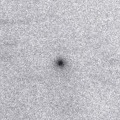
|
Now it is 17.1 mag (July 12, Hidetaka Sato). In the Southern Hemisphere, it keeps observable in good condition for a long time while fading gradually. In the Northern Hemisphere, it keeps extremely low.
Date(TT) R.A. (2000) Decl. Delta r Elong. m1 Best Time(A, h)
Sept.21 5 52.45 -43 56.0 5.041 5.150 90 17.7 4:27 (305, 71)
Sept.28 5 51.89 -44 27.3 5.033 5.187 93 17.7 4:16 (311, 74)
|

|
It has not been observed in this apparition yet. But it must have already brightened up to 18 mag. It will brighten rapidly and will be observable at 15 mag in winter in excellent condition in the Northern Hemisphere. It locates low in the Southern Hemisphere.
Date(TT) R.A. (2000) Decl. Delta r Elong. m1 Best Time(A, h)
Sept.21 4 21.15 33 55.9 1.810 2.330 108 18.1 4:22 (180, 21)
Sept.28 4 28.07 34 56.5 1.702 2.292 113 17.9 4:01 (180, 20)
|
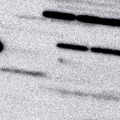
|
Now it is 18.1 mag (Aug. 25, G. Hug). It keeps observable at 17.5 mag in good condition from autumn to winter.
Date(TT) R.A. (2000) Decl. Delta r Elong. m1 Best Time(A, h)
Sept.21 6 29.25 16 19.0 1.893 1.999 80 17.9 4:27 (215, 31)
Sept.28 6 40.93 16 22.4 1.837 2.015 84 17.9 4:16 (214, 32)
|
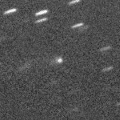
|
Now it is 18.1 mag (Aug. 9, Catalina Sky Survey). It has been observed at 17 mag for a long time from 2009 to 2012. It is also observable at 18 mag in good condition in 2013.
Date(TT) R.A. (2000) Decl. Delta r Elong. m1 Best Time(A, h)
Sept.21 21 27.30 4 59.7 8.626 9.449 143 17.9 21:25 (180, 50)
Sept.28 21 23.87 4 31.8 8.719 9.471 136 18.0 20:54 (180, 50)
|
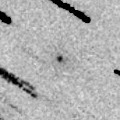
|
Although it was expected to be bright as 16 mag, actually it was so faint as 18.5 mag, fainter than expected by 2-3 mag (Aug. 15, Michael Jager). It will be observable in good condition from summer to autumn, however, it will be only 18-19 mag at best.
Date(TT) R.A. (2000) Decl. Delta r Elong. m1 Best Time(A, h)
Sept.21 4 52.74 24 48.0 0.936 1.521 103 18.7 4:27 (187, 30)
Sept.28 5 2.77 25 2.1 0.920 1.553 107 18.7 4:16 (185, 30)
|
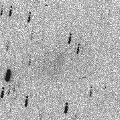
|
It will approach to the Sun down to 0.9 A.U., and to the Earth down to 0.4 A.U. in September. So it was expected to brighten up to 11-12 mag. However, it looked extremely diffuse on July 12 by Michael Jager. So the comet could be already disintegrated at that time. No observations have been reported after that. It keeps locating in good condition after this in the Southern Hemisphere. It is not observable in the Northern Hemisphere.
Date(TT) R.A. (2000) Decl. Delta r Elong. m1 Best Time(A, h)
Sept.21 16 29.85 -45 20.0 0.419 0.991 76 18.9 19:19 ( 57, 57)
Sept.28 17 22.65 -59 1.8 0.471 1.041 81 19.4 19:25 ( 32, 56)
|
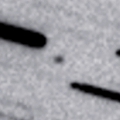
|
It was expected to brighten up to 15 mag in 2013 summer. But actually, it is so faint as 19.5 mag, fainter than expected by 4 mag (July 2, J. F. Soulier). However, J. Linder reported that it is bright as 17.4 mag on Aug. 18.
Date(TT) R.A. (2000) Decl. Delta r Elong. m1 Best Time(A, h)
Sept.21 17 41.83 -11 38.8 2.016 2.213 87 20.6 19:19 (130, 58)
Sept.28 17 34.76 -13 25.9 2.203 2.241 79 20.8 19:25 (115, 52)
|
|
![]()
 C/2010 S1 ( LINEAR )
C/2010 S1 ( LINEAR ) (596) Scheila
(596) Scheila C/2006 S3 ( LONEOS )
C/2006 S3 ( LONEOS ) C/2012 L2 ( LINEAR )
C/2012 L2 ( LINEAR ) C/2012 K1 ( PanSTARRS )
C/2012 K1 ( PanSTARRS ) 29P/Schwassmann-Wachmann 1
29P/Schwassmann-Wachmann 1 C/2011 J2 ( LINEAR )
C/2011 J2 ( LINEAR ) C/2011 L4 ( PanSTARRS )
C/2011 L4 ( PanSTARRS ) C/2012 X1 ( LINEAR )
C/2012 X1 ( LINEAR ) (3200) Phaethon
(3200) Phaethon 117P/Helin-Roman-Alu 1
117P/Helin-Roman-Alu 1 246P/2010 V2 ( NEAT )
246P/2010 V2 ( NEAT ) C/2012 S3 ( PanSTARRS )
C/2012 S3 ( PanSTARRS ) P/2013 CU129 ( PanSTARRS )
P/2013 CU129 ( PanSTARRS ) P/2013 J2 ( McNaught )
P/2013 J2 ( McNaught ) C/2009 F4 ( McNaught )
C/2009 F4 ( McNaught ) 290P/2013 N1 ( Jager )
290P/2013 N1 ( Jager ) C/2013 E2 ( Iwamoto )
C/2013 E2 ( Iwamoto ) 17P/Holmes
17P/Holmes C/2013 A1 ( Siding Spring )
C/2013 A1 ( Siding Spring ) 98P/Takamizawa
98P/Takamizawa 257P/2012 F4 ( Catalina )
257P/2012 F4 ( Catalina ) 84P/Giclas
84P/Giclas 4P/Faye
4P/Faye C/2012 A2 ( LINEAR )
C/2012 A2 ( LINEAR ) 119P/Parker-Hartley
119P/Parker-Hartley C/2011 F1 ( LINEAR )
C/2011 F1 ( LINEAR ) C/2012 J1 ( Catalina )
C/2012 J1 ( Catalina ) C/2012 S4 ( PanSTARRS )
C/2012 S4 ( PanSTARRS ) 291P/2013 N2 ( NEAT )
291P/2013 N2 ( NEAT ) P/2012 F2 ( PanSTARRS )
P/2012 F2 ( PanSTARRS ) C/2012 K8 ( Lemmon )
C/2012 K8 ( Lemmon ) P/2013 O2 ( PanSTARRS )
P/2013 O2 ( PanSTARRS ) 102P/Shoemaker 1
102P/Shoemaker 1 C/2012 C1 ( McNaught )
C/2012 C1 ( McNaught ) C/2010 U3 ( Boattini )
C/2010 U3 ( Boattini ) 292P/2013 O1 ( Li )
292P/2013 O1 ( Li ) C/2011 O1 ( LINEAR )
C/2011 O1 ( LINEAR ) 52P/Harrington-Abell
52P/Harrington-Abell 178P/Hug-Bell
178P/Hug-Bell C/2008 S3 ( Boattini )
C/2008 S3 ( Boattini ) 184P/Lovas 2
184P/Lovas 2 C/2013 G5 ( Catalina )
C/2013 G5 ( Catalina ) C/2012 V1 ( PanSTARRS )
C/2012 V1 ( PanSTARRS )![]()














































